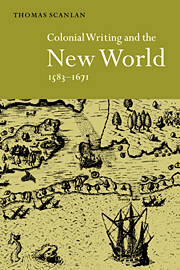Book contents
- Frontmatter
- Contents
- List of illustrations
- Acknowledgments
- Introduction
- 1 The allegorical structure of colonial desire
- 2 Fear and love: two versions of Protestant ambivalence
- 3 Forgoing the nation: the Irish problem
- 4 Preaching the nation: the sermon as promotion
- 5 Love and shame: Roger Williams and A Key into the Language of America
- 6 Fear and self-loathing: John Eliot's Indian Dialogues
- Coda
- Notes
- Index
1 - The allegorical structure of colonial desire
Published online by Cambridge University Press: 04 December 2009
- Frontmatter
- Contents
- List of illustrations
- Acknowledgments
- Introduction
- 1 The allegorical structure of colonial desire
- 2 Fear and love: two versions of Protestant ambivalence
- 3 Forgoing the nation: the Irish problem
- 4 Preaching the nation: the sermon as promotion
- 5 Love and shame: Roger Williams and A Key into the Language of America
- 6 Fear and self-loathing: John Eliot's Indian Dialogues
- Coda
- Notes
- Index
Summary
When he published his Brevíssima relación de la destrucción de las Indias in 1552 in Seville, Bartolomé de Las Casas almost certainly did not foresee the use to which the tract would be put over the next century-and-a-half. To be sure, he intended his brutal exposé of the cruelty and inhumanity of the Spanish in the New World to bring about changes in Spanish colonial policy, but it is highly unlikely that Las Casas, a Catholic Bishop, would have anticipated, or even approved of, the Protestant appropriations of his text with which I will be concerned in this chapter. Translated into English and published in London four times between 1583 and 1699, the Brevíssima relación provided the English Protestants with justification for both their foreign policy toward Spain and their colonial policy in the New World. The cruelty so graphically described in the Brevíssima relación, which the English figured as typically Catholic and Spanish, enabled the English to see colonial endeavor as a means of defining what it meant to be English and what it meant to be Protestant. Moreover, the Protestant appropriation of this quintessentially Catholic text speaks to the methodology that I will employ in this study, for it is with the cultural work of colonial texts in the construction and maintenance of a national identity that I will be most concerned in the pages ahead.
It would be a gross oversimplification to suggest that the publication of one text set the course that English colonialism would take for the next one-hundred-and-fifty years.
- Type
- Chapter
- Information
- Colonial Writing and the New World, 1583–1671Allegories of Desire, pp. 8 - 37Publisher: Cambridge University PressPrint publication year: 1999
- 1
- Cited by



